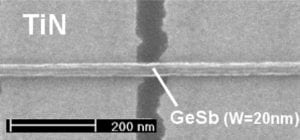PCM, Phase Change Memory, is completing testing and will soon be released; That day will mark the death of flash Memory. Flash is used in millions of devices today,and is considered fast enough to run the most popular operating systems. There are several differences between flash and PCM, especially in how they store data. PCM will be released soon, and will have a huge impact on each of the millions of devices in pockets and pouches around the world. With this in mind, it becomes clear that flash memory is soon to be ancient history.
Flash Memory Enjoys Large Scale Usage
Flash is used in several devices today. For starters, nearly all mobile phones, from the most basic to the most advanced, use flash technology. It is also used as the primary storage device for MacBook Air and Ultra book devices. Other popular devices include: digital cameras and camcorders, SD cards and USB sticks, cable boxes , routers and other network appliances, even game consoles such as XBox. From the creation of the first flash drive, made in 2000 , this technology has made its way in to hundreds of thousands of niches.Why Is It Important, And What Are The Differences
As the video above shows, there are several differences between flash memory and PCM.Because of technical limitations, writing to a flash device cannot be done one bit, or even one byte, at a time as with hard drives. It must be done a block at a time, with a usual block size of 512 bytes. PCM on the other hand, as shown in this Engadget article can write as little as 4 bits, not bytes but bits, a factor which can be important in performance critical applications. Flash technology is much faster than hard drives, which is one reason why Apple’s MacBook Air features a solid-state flash-based hard drive, but the new PCM technology offers even faster speeds, up to 100 times faster. Also, because of limitations in flash technology, commercial grade chips can withstand only 30000 writes, orders of magnitude lower than that required in real world, high demand environments such as data centers. With these limitations, flash has still made quite a name for itself, it is far faster and much more durable than the technology of the time, floppy disks, as well as smaller, but just as floppies are no more, flash is feeling the pinch.PCM Released in 2016 IBM, one of the makers of Phase Change Memory, has set an estimated time of arrival in 2016. This means the technology is less than four years from right now. With this shift in data storage, shifts in internet speeds, cloud technology, and even in the personal computer and mobile phone spaces are sure to be at hand. With companies moving data in enormous quantities, reliable solid-state drives mean faster access, faster delivery. With such great speeds, PCM used in place of today’s DDR chips means computers enjoy instant-on power up. Naturally, some creative inventor will think up whole new ways to enjoy this brake threw, we’ll have to wait and see.To Think About With these things in mind, this really is the best time to upgrade technology for business. Why? Simply this, most components last less than three years in heavy usage environments, so just about the time the old tech is ready for recycling, new tech will be available. In addition, upgrading to new tech now means servers and workstations alike will enjoy the benefits current advances bring over the old. One avenue to consider for upgrading is SMS Modules. SMS buys and sells processors, networking hardware, and of course, DDR. This means businesses can keep the reliable systems they already use, while replacing slower bottle necks with faster components.


Leave a Reply